

What to Do with Six Years of Course Data?!?! After asking colleagues in Planning, I came across some stored reports that contain information about the various awards/courses offered at the university, along with the modules that constitute those awards – from short certificates to full undergraduate and postgraduate degrees.
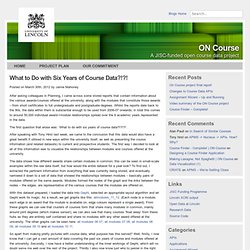
Whilst the reports date back to the 90s, the data within them is substantial enough to be used from 2006-07 onwards; in total this comes to around 50,000 individual award->module relationships spread over the 6 academic years represented in the data. The first question that arose was: ‘What to do with six years of course data?!?!?!’. After speaking with Tony Hirst last week, we came to the conclusion that this data would also have a great benefit if utilised in new ways within the university itself, as well as presenting the course information (and related datasets) to current and prospective students.
So apart from making pretty pictures with course data, what purpose has this served? Using Archimate in the Enable Project. The 7Cs of design and delivery. We are doing a small project at Leicester as part of the JISC-funded OULDI project.
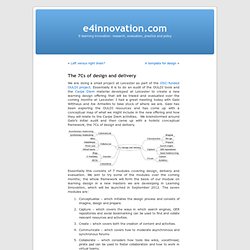
Richard Willis – SharePoint Learning Kit Coordinator, SalamanderSoft Owner » SharePoint vNext to include Education Component. Note: This is all based on preliminary documentation and could all change and so the following is pretty much just speculative.
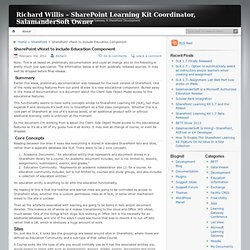
The information below is all from publically released sources. It may well be dropped before final release. Summary Earlier this week, preliminary documentation was released for the next version of SharePoint. One of the really exciting features from our point of view is a new educational component. This functionality seems to have some concepts similar to SharePoint Learning Kit (SLK), but then expands it and obviously it’s built into to SharePoint as a first class component.
As the document I’m working from is about the Client Side Object Model access to the educational features so it’s all a bit of my guess how it all works. Core Concepts Reading between the lines it looks like everything is stored in standard SharePoint lists and sites, rather than a separate database like SLK. An education entity is anything to do with the education functionality.
Contexts of use of Learning Design Support Tools_Insight report-1. Learning Design toolbox. This Cloudscape is a space to collate resources, tools, design methods and activities to enable hands on exploration, and a better understanding of Learning Design.

Objects have been produced by a number of different teams working in this area. The Clouds have been catagorised to allow for 'pick 'n' mix' use (i.e. choose a template, then pick the activities that fit into that template and best meet your learning and teaching needs). Feel free to add resources, activities, tools and methods for design that you are aware of, and please name and tag them using the key below so they can be found easily. Generating Mind Maps from OU/OpenLearn Structured Authoring XML Documents. Guidance on Validation Documents. I'm based in the Learning Development and Innovation team at the University and have been working with the Enable team since the start of 2009.

My focus within the team has been on being able to integrate my previous project work (on creating Best Practice Models for e-learning) with PHOEBE. As part of this work I've been developing some new versions of our validation documents that incorporate guidance and advice for those completing them. Here I have reflected on my experiences to date, with the hope that it will help others considering how to start on the process. Video Diary of curriculum design - Andrew Charlton-Perez.
Xerte - Open Source E-Learning Developer Tools. Welcome to The Xerte Project!
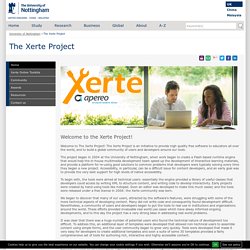
The Xerte Project is an initiative to provide high quality free software to educators all over the world, and to build a global community of users and developers around our tools. The project began in 2004 at the University of Nottingham, when work began to create a Flash-based runtime engine that would help the in-house multimedia development team speed up the development of interactive learning materials, and provide a platform for re-using good solutions to common problems that developers were typically solving every time they began a new project.
Accessibility, in particular, can be a difficult issue for content developers, and an early goal was to provide the very best support for high levels of native accessibility. To begin with, the tools were aimed at technical users: essentially the engine provided a library of useful classes that developers could access by writing XML to structure content, and writing code to develop interactivity. Core Values. RELOAD Project. Main Page - Design for Learning. From Design for Learning Funding for this programme ended in May 2008.
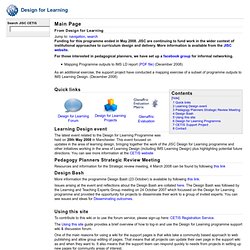
JISC are continuing to fund work in the wider context of institutional approaches to curriculum design and delivery. More information is available from the JISC website. For those interested in pedagogical planners, we have set up a facebook group for informal networking. Mapping Programme outputs to IMS LD report (PDF file) (December 2008) As an additional exercise, the support project have conducted a mapping exercise of a subset of programme outputs to IMS Learning Design. Quick links. The Cloudworks API - rationale and lessons. A few weeks ago I blogged the forthcoming Cloudworks application programming interface and published a document for review.

Today, I thought I would explain some of the decisions behind the design of the API and share some of the lessons we're learning. We'll also touch on Javascript widgets and possible next steps. And, we'll try not to "sell" REST or get into a holy war! Rationale. OLnet One Year on. Latestendeavour Blog. Conole connected june_2010. Sharing the LOAD - Learning Objectives, Activities and Designs. Widget Learning Design Template - Widgets for Inclusive Distributed Environments. T-SPARC Baseline Review @ T-SPARC Blog. Written by tsparcJanuary 18th, 2011 Introduction .

Approach . Methods . Findings and Observations . Reflection Introduction This web-based document constitutes our ‘baseline’ review of curriculum design processes at Birmingham City University. Project Directory. Phoebe — pedagogic planner. ReCourse Learning Design Editor. ReCourse is a tool to create IMS Learning Design compliant Units of Learning.
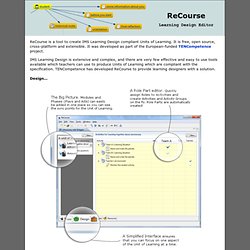
It is free, open source, cross-platform and extensible. It was developed as part of the European-funded TENCompetence project. IMS Learning Design is extensive and complex, and there are very few effective and easy to use tools available which teachers can use to produce Units of Learning which are compliant with the specification. TENCompetence has developed ReCourse to provide learning designers with a solution. Design Bash 2010. My Presentations. The Design Studio / FrontPage. CompendiumLD learning design software. Dynamic Learning Maps. XCRI: eXchanging Course-Related Information. XCRI: eXchanging Course-Related Information. Institutional approaches to curriculum design. This programme has now completed. Transforming curriculum delivery through technology. See the synthesis report providing an overview of the programme and lessons learnt1 See the summary report providing an overview of approaches to evaluation across the programme1 See all the outputs from this programme at the Design Studio2 This programme has now completed.
Sheila’s work blog. Bill Clinton isn’t the only one creating a buzz about the open badges movement at the moment. Perhaps with slightly less coverage than the Clinton initiative, yesterday saw the first (Scottish) open badges working group meeting. Organised by Grainne Hamilton at RSC Scotland, following the success and interest shown at their recent Open Badges Design Day, the meeting was very well attended with a group of really enthusiastic practitioners from across the Scottish education sector, many of whom are already implementing badges.
There was also good representation from key agencies such as the SQA and the Colleges Development Network. What struck me about the meeting was how much real buy-in and activity there was for badges from schools to colleges to universities. There was also a lot of interest in using badges for staff development within colleges and universities. CIRCLE - A Curriculum Design and Delivery Community supported by. Main Page - Design for Learning. Managing Curriculum Change. Download this document1 Order a hard copy2. Design_for_learning. LAMS: Learning Activity Management System.